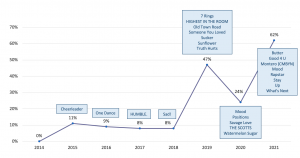Shorter song lengths are currently one of the hottest trends in today’s mainstream.
The average length of a Hot 100 Top 10 hit plummeted from 3:36 in 2018 down to just 3:10 in 2019 and held steady ever since. This drop-off is coupled with a surge of songs landing under three-minutes in length, which, for the first time in many years, are the most popular at 43% of all Top 10s.
Does this trend hold true for #1 hits as well?
The rise among chart-toppers has been even more drastic. From 2018 to 2019, the number of #1 hits landing under three minutes more than quintupled to nearly half of all songs. After a dip down to one-quarter of songs in 2020, it drastically shot back up once again to nearly two-thirds YTD 2021 (as of chart dated 8/28/21).
#1 Hits Landing Under 3:00 (2014 – YTD 2021)
So why the drastic surge in super-short songs?
One possible reason is short audience attention spans due in part to the popularity of streaming and rapid-fire content apps like TikTok. When songs are kept short, listeners have less time to get bored and lose interest; by the time they get the urge to skip to the next song, it’s already over. Hit and run songwriting, so to speak. And this goes hand-in-hand with another possible reason: to garner repeat listens. By keeping songs short, listeners may be more inclined to go back for another listen, which lends itself well to today’s streaming era.
How are writers keeping their songs so short?
The methods used to shorten a song’s length plays a huge role in keeping today’s fast-paced listeners engaged. Among them are shortening the length of sections, which results in more frequent material turnover; omitting “optional” song sections like the intro, pre-chorus, post-chorus, bridge or outro; and/or using faster tempos to bring the song to a quicker conclusion.
A perfect case-in-point is The Kid LAROI and Justin Bieber’s Stay, which is currently the shortest #1 hit of 2021.
It employs all the aforementioned techniques to keep its length down to an exceptionally short 2:15:
- Short Song Sections: Six out of its nine sections clock in at just 11 seconds in length. Choruses 2 and 3 clock in at a more typical 22 seconds, which gives the listener a healthy dose of the song’s main hooks following the half-length chorus 1. And verse 2, which is sung entirely by Bieber and also sits at a lengthier 22 seconds, achieves two key things: it provides more detail to the story and gives Justin Bieber, who is by far the more recognizable of the song’s two artists, a longer time in the spotlight.
- Song Section Omissions: Stay omits three sections that are all quite popular among non-hip hop hits: the post-chorus, bridge and an additional chorus that would typically follow the bridge. Instead, the song’s writers kill two birds with one stone and use the third chorus as an engaging departure in place of the bridge, breaking down to a sparse, vocoder-centric arrangement that contrasts the rest of the song.
- Fast Tempo: Also contributing to Stay’s short length is its uncommonly fast tempo. In fact, Stay is the fastest #1 hit so far in 2021, clocking in at a speedy 170 BPM. To put this into perspective, the runner-up Permission To Dance follows at a distant 125 BPM. In addition to keeping the song short, Stay’s fast tempo also jibes with its 1980s new wave influence, a genre that typically sits at faster tempos, and takes after the new wave-inspired megahit Blinding Lights (which clocks in at 171 BPM).
And of course, the song would not be complete without its stellar melody and hooks, all of which are highly repetitive and help to keep the song memorable despite its short length. Together with the song-shortening techniques above, this helped prime Stay to succeed among mainstream audiences’ ever-shortening attention spans, ultimately helping it rise to the top spot on the chart.


